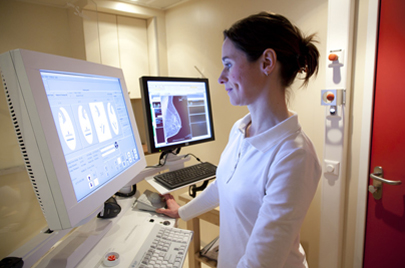 An important screening tool, mammography involves the use of an x-ray machine to diagnose breast diseases such as cancer. A mammogram makes diagnosis possible at an early stage, even before a cancerous tumor is felt. Early detection is crucial to prevent the spread of the disease, or at least, minimize its progression.
An important screening tool, mammography involves the use of an x-ray machine to diagnose breast diseases such as cancer. A mammogram makes diagnosis possible at an early stage, even before a cancerous tumor is felt. Early detection is crucial to prevent the spread of the disease, or at least, minimize its progression.
Every woman needs to be aware about mammograms – the different types and what the procedure involves.
Different Types
- Screening mammography: This screening method is a precautionary measure for women with no signs or symptoms of breast cancer.
- Diagnostic mammography: This method inspects the breast for tumors. A mammogram that tests positive during a screening exam can be confirmed with this method. The area with abnormalities is further evaluated by magnifying it. A clearer version of the picture will be submitted for closer examination.
- Breast tomosynthesis mammography: This relatively new method produces a 3-D picture, allowing an easier and more accurate breast examination. This is the most reliable tool to find cancerous tumors in the breast, though are risks of increased radiation.
Things You Need to Know About Having Mammograms
- Mammograms can save your life. Early detection of breast cancer reduces your risk of dying from the disease by 25-30% or more.
- Women at a higher risk of the disease should begin having mammograms yearly at age 40 or even earlier.
- Mammography is a pretty fast procedure and generally takes only about 20 minutes. It is safe and for women, discomfort is minimal.
- If you are not comfortable waiting for the results, choose a screening center that provides the results the same day.
- Getting a digital mammogram if you are under age 50 and have dense breasts is a good option as it can be enlarged for better examination.
- Past mammogram films/results should be made available to the person evaluating the results so that they can be compared.
- Do not to use a deodorant or antiperspirant when you go in for a mammogram. Doing so can interfere with the results.
- Though mammography is the most powerful breast cancer detection tool, it can still miss 20% of breast cancers that are not visible using this technique.
Finally, don’t reach the conclusion that you cancer if your mammography results are positive and you are called for further tests. About 10% of women who have had a mammogram will require more tests, according to the American Cancer Society. Only 8-10% of these women will require a biopsy and about 80% of these biopsies will not be cancer.